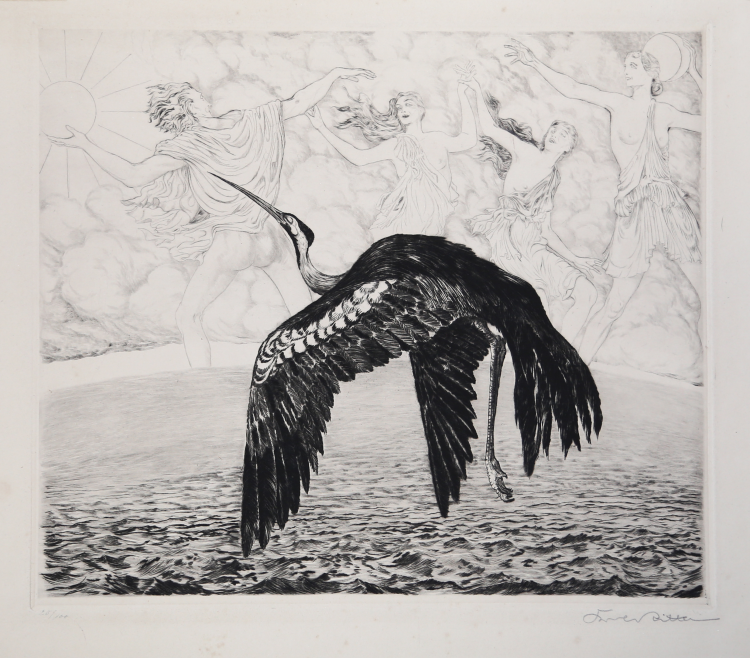



| Reference: | S7676 |
| Author | Karl RITTER |
| Year: | 1920 ca. |
| Measures: | 345 x 290 mm |


| Reference: | S7676 |
| Author | Karl RITTER |
| Year: | 1920 ca. |
| Measures: | 345 x 290 mm |
Drypoint and etching, 1920 circa, signed in pencil at lower right. Limited edition of 100 copies, of which the present example is numbered 25, lower left.
In the foreground is depicted a bird, similar to a grey heron, with wings spread in flight over the water, the beak, very thin and elongated, pointing up and touches the male figure, back, with the sun in his left hand (identifiable with Apollo), about to launch the sphere towards the most distant of the three female figures, which in turn is about to launch the moon - a slice - which has in the left (Selene or Diana), the center, two girls participate in the game.
In mythology and in fables crane, heron and stork are often confused among them to the point that it is not always possible to distinguish them.
Mythology associates the name of the crane with that of a particular dance called gèranos, or dance of the cranes, a spring dance that symbolized the beginning of the good season and the new year; the crane was a bird sacred to Apollo as an emblem of spring and light. Therefore, the engraving could depict an Allegory of Spring.
Karl Ritter was born on November 7, 1888 in Wurzburg, Germany. The son of an opera singer and music professor, Ritter embarked on a military career before studying architecture in Munich. Turning to the graphic arts and painting, he became involved in the film industry through his employment as a public relations agent for Sudfilm in 1926, editing a book of Walt Disney cartoons. He subsequently worked as a production manager and screenwriter, also directing a short film for comedian Karl Valentin in 1932. Owing to his early membership in the Nazi party, Ritter’s film career progressed quickly following his signing a contract with Ufa in 1933. His first film as a producer was “Hitlerjunge Quex” (Hitler Youth Quex, 1933), one of the first films of the era to openly glorify the Nazi party.
Ritter was appointed to Ufa board of directors and went on to make “Weiberregement” in 1936, “Capriccio” in 1938, “Patrioten, 1937 and “Stukas” in 1940/41, the story of a young bomber pilot whose depression and apathy was cured by Wagner’s “Götterdämmerung.” He also did a number of blatant anti French, Russian and British propaganda films. He was taken prisoner by the Soviets but escaped and in 1949 he emigrated to Argentina where Winifred Wagner, Richard Wagner's English daughter-in-law, helped him establish a film production company. He made the film “El Paraiso” there in 1951.
|
Karl Ritter was born on November 7, 1888 in Wurzburg, Germany. The son of an opera singer and music professor, Ritter embarked on a military career before studying architecture in Munich. Turning to the graphic arts and painting, he became involved in the film industry through his employment as a public relations agent for Sudfilm in 1926, editing a book of Walt Disney cartoons. He subsequently worked as a production manager and screenwriter, also directing a short film for comedian Karl Valentin in 1932. Owing to his early membership in the Nazi party, Ritter’s film career progressed quickly following his signing a contract with Ufa in 1933. His first film as a producer was “Hitlerjunge Quex” (Hitler Youth Quex, 1933), one of the first films of the era to openly glorify the Nazi party.
Ritter was appointed to Ufa board of directors and went on to make “Weiberregement” in 1936, “Capriccio” in 1938, “Patrioten, 1937 and “Stukas” in 1940/41, the story of a young bomber pilot whose depression and apathy was cured by Wagner’s “Götterdämmerung.” He also did a number of blatant anti French, Russian and British propaganda films. He was taken prisoner by the Soviets but escaped and in 1949 he emigrated to Argentina where Winifred Wagner, Richard Wagner's English daughter-in-law, helped him establish a film production company. He made the film “El Paraiso” there in 1951.
|
|
Karl Ritter was born on November 7, 1888 in Wurzburg, Germany. The son of an opera singer and music professor, Ritter embarked on a military career before studying architecture in Munich. Turning to the graphic arts and painting, he became involved in the film industry through his employment as a public relations agent for Sudfilm in 1926, editing a book of Walt Disney cartoons. He subsequently worked as a production manager and screenwriter, also directing a short film for comedian Karl Valentin in 1932. Owing to his early membership in the Nazi party, Ritter’s film career progressed quickly following his signing a contract with Ufa in 1933. His first film as a producer was “Hitlerjunge Quex” (Hitler Youth Quex, 1933), one of the first films of the era to openly glorify the Nazi party.
Ritter was appointed to Ufa board of directors and went on to make “Weiberregement” in 1936, “Capriccio” in 1938, “Patrioten, 1937 and “Stukas” in 1940/41, the story of a young bomber pilot whose depression and apathy was cured by Wagner’s “Götterdämmerung.” He also did a number of blatant anti French, Russian and British propaganda films. He was taken prisoner by the Soviets but escaped and in 1949 he emigrated to Argentina where Winifred Wagner, Richard Wagner's English daughter-in-law, helped him establish a film production company. He made the film “El Paraiso” there in 1951.
|